July 1985.
The first-ever peace talks between the Sri Lankan government, Tamil rebels and Tamil political parties were held in the Bhutanese capital of Thimpu. The government delegation was led by H W Jayewardene, a younger brother of the then President J.R. Jayewardene and included the late Supreme Court Judge Mark Fernando, as well as the late eminent lawyer H L de Silva and S L Gunasekara.Tamil militant groups were represented by LTTE leader Velupillai Prabhakaran as well as Uma Maheswaran and Sri Sabaratnam.
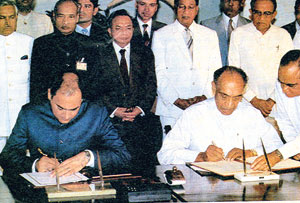 |
| The signing of the Indo-Lanka Accord in July 1987 |
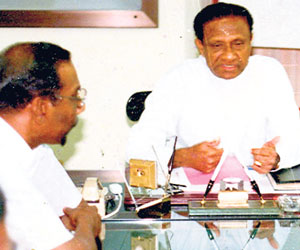 |
| LTTE theoretician Anton Balasingham in coversation with President Premadasa during the 1990 peace talks |
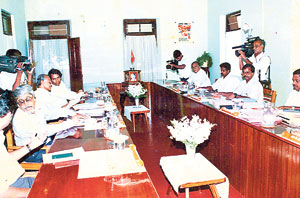 |
| Peace talks during the Chandrika Kumaratunga regime |
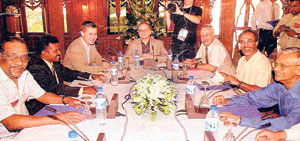 |
| Peace talks with the Wickremesinghe government in Thailand |
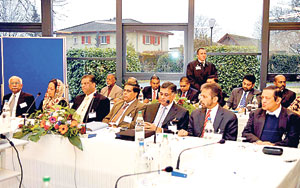 |
| The Rajapaksa delegation talking peace with the Tigers in Geneva |
The latter two were subsequently killed on the orders of Prabhakaran. The other Tamil delegates included Douglas Devananda, (now Minister of Social Services) and former TULF leaders A Amirthalingam (who was also subsequently assassinated by the LTTE) and S Sivasithamparam.
July 1987
The second attempt at reaching a peaceful settlement to the conflict began with India's active intervention.
This resulted in the signing of the Indo-Lanka Peace Accord by the then Indian Prime Minister Rajiv Gandhi and Sri Lankan President Junius Jayewardene. Under Indian pressure, Prabhakaran endorsed the accord and agreed to lay down arms and accept the devolution of power on a provincial basis.
However the signing of the accord sparked protests in several parts of the country particularly in Colombo. The accord paved the way for Indian troops to be deployed in the north and east to oversee the implementation of the Peace Pact.
After a symbolic laying down of arms, the LTTE soon began battling the Indian army. More than 1,500 Indian troops were killed and they left the country soon after President R. Premadasa was elected to office in December, 1988.
February 1990
After Ranasinghe Premadasa was elected president, succeeding Jayewardene, there was a fresh attempt to reach a negotiated settlement to the conflict. Official talks began in February 1990 at the Hilton Hotel in Colombo.
The LTTE delegation comprised the Group's then political wing leader Yogaratnam Yogi as well as its theoretician Anton Balasingham and his Australian-born wife, Adele.
However in this instance, too, the Tigers after having acquired a large stock of weapons from the Premadasa regime to fight the Indian-installed TNA, the LTTE resumed its attacks on the military. Premadasa was assassinated by a suicide bomber on May 1, 1993.
October, 1994
The next attempt at peace negotiations was made in October 1994 after Chandrika Kumaratunga won both the parliamentary and presidential elections, ending the 17-year rule by the UNP.
The government delegation was led by Presidential Secretary Kusumsiri Balapatabendi while the LTTE delegation was led by its political wing leader S.P. Thamilselvan.
However, after four rounds of talks that lasted till April, 1995, the process ended abruptly with the LTTE launching an attack on the Sri Lankan navy in Trincomalee.
February 2002
With the UNP winning the parliamentary elections in December, 2001 and the appointment of Ranil Wickremesighe as Prime Minister, the stage was set for another attempt at peace. The new government signed a Norwegian brokered Ceasefire Agreement (CFA) with the LTTE. Talks were held in Thailand and Japan. However, after six rounds of talks, the LTTE told the Wickremesinghe government in April, 2003 that the group had decided to suspend its participation in the peace talks.
February 2006
After President Mahinda Rajapaksa was elected to office, he resumed the peace process with two rounds of peace talks being held in Geneva in February and April 2006. However, the third round of talks which was scheduled to be held in the Norwegian capital, Oslo, from June 8-9 never took place even though both delegations arrived there for the talks. The LTTE delegation refused to attend the talks, saying the Government delegation was under-represented.
January 2008
The government withdrew from the Ceasefire Agreement (CFA) |





